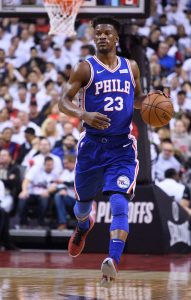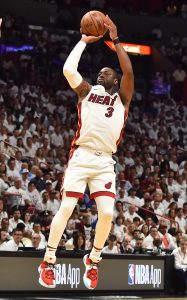Hoops Rumors is breaking down the 2019 offseason for all 30 NBA teams, revisiting the summer’s free agent signings, trades, draft picks, departures, and more. We’ll evaluate each team’s moves from the last several months and look ahead to what the 2019/20 season holds for all 30 franchises. Today, we’re focusing on the Miami Heat.
Signings:
- Standard contracts:

- Jimmy Butler: Four year, maximum salary ($140.79MM). Fourth-year player option. 15% trade kicker. Acquired via sign-and-trade.
- Udonis Haslem: One year, minimum salary. Re-signed using minimum salary exception.
- Two-way contracts:
- Non-guaranteed camp contracts:
Trades:
- Acquired No. 44 pick in 2019 draft (used to select Bol Bol) from the Hawks in exchange for the Heat’s 2024 second-round pick (protected 31-50 and 56-60) and cash ($1.88MM).
- Acquired either the Nuggets’ or Sixers’ second-round pick (whichever is least favorable) and cash ($1.2MM) from the Nuggets in exchange for the draft rights to Bol Bol (No. 44 pick).
- Acquired the draft rights to KZ Okpala (No. 32 pick) in a three-team trade with the Pacers and Suns in exchange for the Heat’s 2022 second-round pick, the Heat’s 2025 second-round pick, and the Heat’s 2026 second-round pick (all sent to Pacers).
- Acquired Jimmy Butler (sign-and-trade), Meyers Leonard, and cash ($110K) in a four-team trade with the Sixers, Trail Blazers, and Clippers in exchange for Josh Richardson (to Sixers), Hassan Whiteside (to Blazers), and the Heat’s 2023 first-round pick (top-14 protected; to Clippers).
Draft picks:
- 1-13: Tyler Herro — Signed to rookie contract.
- 2-32: KZ Okpala — Signed to three-year, minimum salary contract. Fully guaranteed. Signed using mid-level exception.
Departing players:
Other offseason news:
- Signed head coach Erik Spoeltra to four-year extension.
- Exercised 2020/21 rookie scale option on Bam Adebayo.
- Assistant coach Juwan Howard left for Michigan.
- Named Eric Glass head coach of Sioux Falls Skyforce (G League affiliate).
Salary cap situation:
- Remained over the cap.
- Carrying approximately $134.44MM in guaranteed salary.
- Hard-capped (within approximately $1MM of hard cap).
- $8.36MM of mid-level exception still available (used $898K on KZ Okpala).
- Full bi-annual exception ($3.62MM) still available.
- Note: Due to hard cap, Heat would have to reduce salary elsewhere in order to use full MLE and/or BAE.
- $6.27MM traded player exception available (expires 2/6/20).
Story of the summer:
Entering the 2019 offseason, the Heat’s ability to make a competitive bid for any of the summer’s top free agents looked extremely limited. Not only was team salary well above the projected cap, but there was no guarantee the club would even be able to stay below the tax line. Going after a maximum-salary free agent seemed like a pipe dream.
Well, that was the perception from outside the organization at least. Within the front office, Pat Riley and his management team weren’t about to let a few cap limitations get in the way of pursuing a star.
Riley and the Heat made good on that plan, acquiring Jimmy Butler in a sign-and-trade deal with the Sixers that didn’t require the team to create cap room. Still, while Miami’s creative approach to landing an impact player is laudable, it’s also worth noting how many sacrifices the team had to make to get it done.
The sign-and-trade deal for Butler didn’t just include the Sixers — two other teams had to get involved too in order to meet salary-matching requirements, and the Heat had to part with promising youngster Josh Richardson and a future first-round pick in the process. Plus, as a result of acquiring a player via sign-and-trade, Miami is now hard-capped for the rest of the 2019/20 league year, all but eliminating the possibility of adding a 15th man to the opening-night roster or making any additional trades that involve taking on excess salary.
If Miami had the cap room to sign Butler outright, none of those steps would have been necessary. But, as a result of pricey contracts handed out to Goran Dragic, James Johnson, Dion Waiters, and Hassan Whiteside (dealt to Portland in the Butler sign-and-trade), the team didn’t have the flexibility to create a max-salary slot under the cap. And now its flexibility for the rest of the season will be hampered to an even greater degree.
For the Heat though, that trade-off was a necessary evil. They believe Butler was worth both the investment ($140MM+) and the cap machinations necessary to bring him aboard. Now that he’s under contract for the next four years, Miami will have the opportunity to continue building around him once those undesirable contracts start to expire.
Read more
Key offseason losses:
The Heat only lost five players this offeason, and two of them – Ryan Anderson and Yante Maten – didn’t have particularly lengthy or memorable stays in Miami. The other three are worth singling out, however.
This isn’t the first time Dwyane Wade has departed from the Heat. He also left during the 2016 offseason to sign with Chicago before eventually returning during the 2017/18 season. The future Hall-of-Famer’s departure feels a little more definitive this time around though, since he has formally retired as a player.
Wade retires as the Heat’s all-time leader in games played, points, assists, steals, and several other key categories, and in many cases, no one came close to his numbers. Wade’s 21,556 points, for instance, more than double the total of runner-up Alonzo Mourning (9,459).
The 13-time All-Star will be remembered more fondly in South Beach for his role on the Heat’s championship teams in 2006, 2012, and 2013 than he will for his final season and a half with the organization, but it will still be an adjustment to watch a Wade-less Heat team going forward.
Richardson and Whiteside, meanwhile, left the Heat as part of the Butler sign-and-trade. The team was reluctant to include Richardson in trade offers for Butler last fall, but seemingly became more inclined to move him after a 2018/19 season in which his efficiency stats took a hit as he assumed more play-making responsibilities — his .412 FG% and .357 3PT% were noticeable steps down from his 2017/18 marks (.451 FG%, .378 3PT%).
As for Whiteside, the big man is an exceptional rebounder and shot blocker, but had seen his minutes cut back in recent years, a trend that was likely to continue as Bam Adebayo took on more responsibilities. It made sense to move him rather than risk him once again expressing frustration with his reduced playing time.
Key offseason additions:
We’ve already devoted a few paragraphs to the acquisition of Butler, but it’s worth reiterating what a good fit he can be in Miami. The Heat are known across the league for a culture built on a relentless work ethic and a commitment to conditioning, traits that are right up Butler’s alley.
The standout swingman can match up with opponents’ top wing scorer on the defensive side of the ball and – as he showed in last year’s playoff series vs. Toronto – he’s more than capable of generating offense too. While he may not be a top-five or top-10 player in the NBA, his ability to make an impact on both ends of the floor should help increase Miami’s ceiling this season.
Butler wasn’t the only notable addition for the Heat this summer. The team has been raving this fall about rookie shooting guard Tyler Herro, the 13th overall pick in the 2019 draft. Of the nine players who averaged at least 3.4 three-point attempts per game for the Heat last season, five left the team during the season or in the summer, so Herro’s ability to let it fly from outside and space the floor for teammates will be valuable, even if other aspects of his game take a little longer to come around.
Meyers Leonard, who was acquired from Portland in the Butler sign-and-trade, also enters the mix at center this season, though it’s unclear how big a role he’ll play. Adebayo and Kelly Olynyk should receive most of the available minutes at the five, but Leonard could potentially play alongside one of them in certain lineups. He’d also be leaned on more heavily if Olynyk’s ankle injury continues to bother him into the regular season.
Outlook for 2019/20:
The Heat have essentially been a .500 team in recent years, winning between 39 and 44 games in each of the last three seasons and missing the playoffs in two of those seasons. Adding Butler should put the team in better position to surpass that 44-win mark and more comfortably earn a postseason spot in 2019/20, but that’s hardly a lock.
Due to the cap machinations required to make the Butler acquisition work, the Heat may not have the flexibility necessary to make significant adjustments or upgrades to the current roster, or to add needed reinforcements if they’re hit hard by the injury bug.
It would be a slight upset if Miami misses the playoffs altogether, but either way, this roster still seems to be at least a move or two away from becoming a legit contender in the East.
Salary information from Basketball Insiders was used in the creation of this post. Photos courtesy of USA Today Sports Images.

